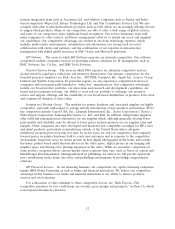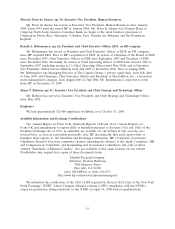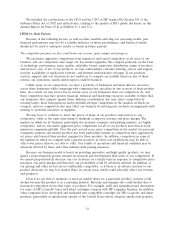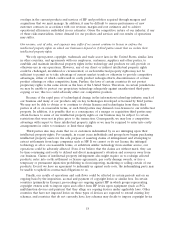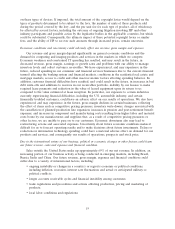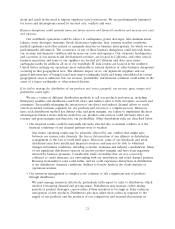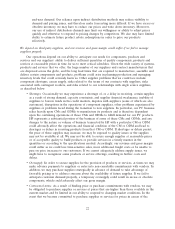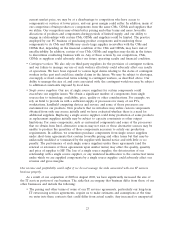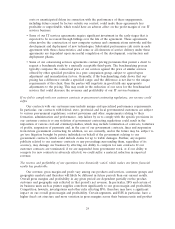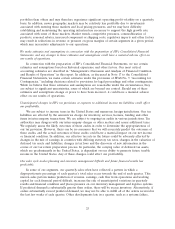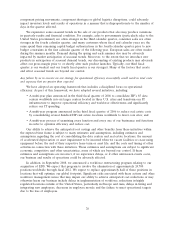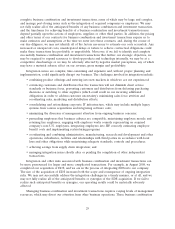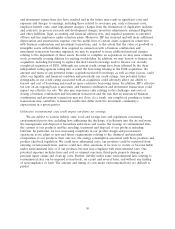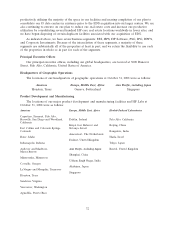HP 2008 Annual Report Download - page 28
Download and view the complete annual report
Please find page 28 of the 2008 HP annual report below. You can navigate through the pages in the report by either clicking on the pages listed below, or by using the keyword search tool below to find specific information within the annual report.end-user demand. Our reliance upon indirect distribution methods may reduce visibility to
demand and pricing issues, and therefore make forecasting more difficult. If we have excess or
obsolete inventory, we may have to reduce our prices and write down inventory. Moreover,
our use of indirect distribution channels may limit our willingness or ability to adjust prices
quickly and otherwise to respond to pricing changes by competitors. We also may have limited
ability to estimate future product rebate redemptions in order to price our products
effectively.
We depend on third-party suppliers, and our revenue and gross margin could suffer if we fail to manage
suppliers properly.
Our operations depend on our ability to anticipate our needs for components, products and
services and our suppliers’ ability to deliver sufficient quantities of quality components, products and
services at reasonable prices in time for us to meet critical schedules. Given the wide variety of systems,
products and services that we offer, the large number of our suppliers and contract manufacturers that
are dispersed across the globe, and the long lead times that are required to manufacture, assemble and
deliver certain components and products, problems could arise in planning production and managing
inventory levels that could seriously harm us. Other supplier problems that we could face include
component shortages, excess supply, risks related to the terms of our contracts with suppliers, risks
associated with contingent workers, and risks related to our relationships with single source suppliers,
as described below.
•Shortages. Occasionally we may experience a shortage of, or a delay in receiving, certain supplies
as a result of strong demand, capacity constraints, and supplier financial weaknesses, inability of
suppliers to borrow funds in the credit markets, disputes with suppliers (some of which are also
customers), disruptions in the operations of component suppliers, other problems experienced by
suppliers or problems faced during the transition to new suppliers. In particular, our PC business
relies heavily upon CMs and ODMs to manufacture its products and is therefore dependent
upon the continuing operations of those CMs and ODMs to fulfill demand for our PC products.
HP represents a substantial portion of the business of some of these CMs and ODMs, and any
changes to the nature or volume of business transacted by HP with a particular CM or ODM
could adversely affect the operations and financial condition of the CM or ODM and lead to
shortages or delays in receiving products from that CM or ODM. If shortages or delays persist,
the price of these supplies may increase, we may be exposed to quality issues or the supplies
may not be available at all. We may not be able to secure enough supplies at reasonable prices
or of acceptable quality to build products or provide services in a timely manner in the
quantities or according to the specifications needed. Accordingly, our revenue and gross margin
could suffer as we could lose time-sensitive sales, incur additional freight costs or be unable to
pass on price increases to our customers. If we cannot adequately address supply issues, we
might have to reengineer some products or service offerings, resulting in further costs and
delays.
•Oversupply. In order to secure supplies for the provision of products or services, at times we may
make advance payments to suppliers or enter into non-cancelable commitments with vendors. In
addition, we may purchase supplies strategically in advance of demand to take advantage of
favorable pricing or to address concerns about the availability of future supplies. If we fail to
anticipate customer demand properly, a temporary oversupply could result in excess or obsolete
components, which could adversely affect our gross margin.
•Contractual terms. As a result of binding price or purchase commitments with vendors, we may
be obligated to purchase supplies or services at prices that are higher than those available in the
current market and be limited in our ability to respond to changing market conditions. In the
event that we become committed to purchase supplies or services for prices in excess of the
22


